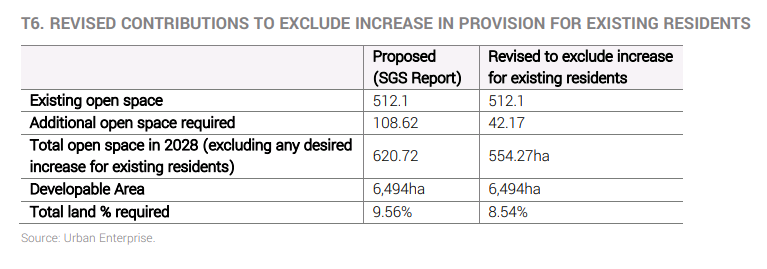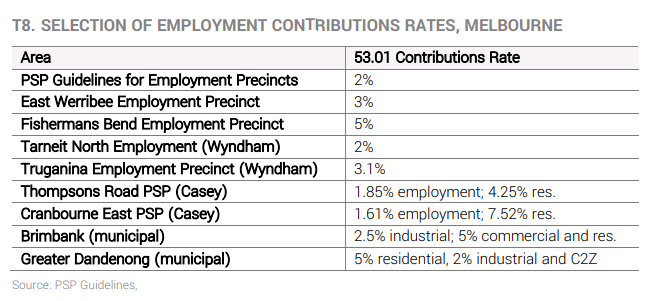On Monday 17th Feb, an independent Planning Panel commenced for the hearing of the Amendment C148 proposed by the Monash Council. Following the footsteps of Frankston City Council, who successfully increased their public open space contribution rates, Monash Council proposed amendment C148, an amendment that is much heavier handed and is one of the highest of any council.
Amendment C148 proposes to increase the public open space contribution requirement for subdivisions of 3 lots or more to 10% cash, 10% land, or a mix of both. More on Amendment C148 can be found here.
In the Evidence statement prepared by Dr Marcus Spiller, supporting the City of Monash, Dr Spiller provided justification on why Council should adopt a rate 30 square metres of Open Space per person which in turn, translates to requirement of 620.72 hectares of Open Space in City of Monash by 2028. Ultimately arriving at the uniform 10% contribution rate for Monash. You can download the Evidence statement prepared by Dr Marcus Spiller here.
Supporting Salta Properties, Golf Road Project Development and Talbot Road Finance, Matt Ainsaar, Managing Director and founder of Urban Enterprise, been instructed to prepare an expert evidence statement and present at the Planning Panel hearing.
In Mr Ainsaar’s expert view, there are three main issues with the Amendment relevant to open space contributions:
- The appropriateness of the open space calculation method applied to determine the 30 square metres per person;
- The suitability of the provision standard of 30sqm per person; and
- The equity of applying a single rate to all land uses and areas within the municipality.
The appropriateness of the open space calculation method applied to determine the 30 square metres per person for subdivision
Mr Ainsaar first assumes the calculation for the open space contributions rate for the Amendment were to be accepted, in his view there are considerable issues and inequities that warrant changes to the proposed contributions rate.
The rate is calculated on the basis of an open space target of 30sqm per resident which applies to all residents in the municipality in 2028, including both existing and projectednew residents, yet the current open space provision in the municipality is 27sqm per resident. In other words, the methodology applied acknowledges that there is an existing shortfall or open space “gap” that applies to the 192,850 existing residents.
This means that the target quantum of open space requires an increase in the open space provision for all existing residents (of 3.5 sqm per existing resident) as well as a new provision of 30sqm per new resident. The effect of this is that, as a result of the Amendment, new development would be making both:
- A contribution of land to meet the needs of the development; and
- A contribution which would result in an increase in the overall open space provision for all existing residents.
Table below shows that of the 108.62 additional hectares of open space that the SGS report identifies as needed to achieve the target provision of 30qm per resident in 2028, 66.45 ha (61%) relates to the amount of additional land required to increase the provision of open space per existing resident.

Mr Ainsaar believes it is inequitable for new development to be required to make a contribution to open space which is calculated on the basis of increasing the provision of open space for existing residents. If the method were to be recalculated to exclude the targeted increase in open space for existing residents, the outcome would be maximum contributions rate of 8.54% as show in the table below

The suitability of the provision standard of 30sqm per person for future subdivision town planning permits
Mr Ainsaar argues the Amendment relies on an open space provision target of 30sqm per resident which the Explanatory Report notes is “consistent with the provision of open space required in the planning for new housing in Melbourne’s growth areas”.
In his opinion, the Amendment adopts an overall open space provision target that is high relative to recently approved strategies and Precinct Structure Plans and which has insufficient regard to the population density and accessibility.
The SGS report shows that the provision target has been derived from a range of local, national and international examples which generally range from 20sqm to 30sqm per capita. The SGS report also notes that “A number of Melbourne based local governments apply a per capita provision rate to determine open space standards, and typically range between 24 and 30.3 square metres per capita.”
Mr Ainsaar reviewed the open space provision targets for four recent established area open space strategies in Melbourne, and four recently approved Precinct Structure Plans in Melbourne’s growth areas.

The provision standard adopted for Monash of 30sqm per resident is considerably higher than that recently adopted for activity centres in Kingston and Manningham (10sqm per resident) and is higher than the open space provision rate in recent growth areas (which ranges from 19sqm to 23sqm per resident).
Giving consideration to population densities increase, the provision of a specified quantity of open space per resident becomes less practical. Using Fishermans Bend as example, the open space strategy “sets a target of nine square metres per resident and worker, based on recommendations of the World Health Organization” The Planning Review Panel found that “The proposed quantity and distribution of open space in Fishermans Bend is broadly acceptable”. If a standard of 30sqm per resident were to be provided in Fishermans Bend, the 80,000 residents would require a total of 240 hectares of open space. This would take up more than 70% of the Net Developable Area in Fishermans Bend (340ha) which is clearly not a feasible outcome.
In his view, the selection of an open space provision target, if applied, should have regard to:
- The existing provision of open space;
- The existing and proposed population density; and
- A concurrent target relating to accessibility, so as not to solely rely on a quantitative target.
In the evidence statement prepared by Matt Ainsaar, he further points out Jells Park is one of the largest open spaces in the municipality, however this major park has been deducted from the calculation of open space provision per resident on the basis that it is classified as a regional open space. When Jells Park is included in the open space provision, the existing provision of open space per capita increases from 27sqm per resident to 41.25sqm per resident. This rate of provision comfortably exceeds Council’s own planning benchmark of 30sqm per resident. Despite not being a Council-owned open space, residents across the municipality, and especially in the eastern part of Monash, will clearly benefit from the availability of passive recreation opportunities in Jells Park and the broader Dandenong Valley Parklands. In his view, it is misleading to exclude Jells Park from the calculation of open space per resident.
Equity of applying the same rate to subdivision in all land uses
The Amendment proposes to apply a single open space contributions rate to all precincts across the municipality and all land uses, including residential, retail, commercial and industrial.
This would mean that, for example, an industrial subdivision in Mount Waverley would make the same contribution (in percentage terms) as a residential subdivision in Clayton.
The open space target on which the contributions rate is calculated relates solely to open space per resident. Although it is common for open space strategies to express open space provision in terms of provision per resident, in practice the open space also services workers, albeit in a different way
In his view, it is entirely inequitable for employment land uses to be required to make a contribution to public open space equivalent to 10% of the land area or site value when:
- The need for open space has not been demonstrated in the supporting material; and
- There is consistent evidence which demonstrates that the quantity of open space required to meet the needs of workers is considerably less than the quantity needed for residents.
Across Wyndham and Casey, open space contributions in employment areas are generally between 1.6% and 3.1%. In the municipalities of Brimbank and Greater Dandenong where there is considerable land for employment purposes, a lower contributions rate is applied to industrial (2% or 2.5%) than is applied to residential development (5%) as part of a municipal-wide approach to contributions.

In his view, the MOSS does not provide sufficient justification to support the application of a very high rate of 10% to employment land in the municipality.
An alternative way forward
Mr Ainsaar concludes that the proposed rates should be set aside and replaced through a more robust, suitable and equitable method of calculating the contributions rate for subdivision. The Panel should also consider:
- There is no justification in the material supporting the Amendment for a public open space contributions rate for residential development higher than 5%; and
- The contribution for employment land uses should be lower than the rate for residential development – a contribution in the order of 2-3% would be appropriate.
Panel Hearing and other Evidence Statements
The independent planning panel hearing takes place from Monday 17 February 2020 and will go for 4 days.
City of Monash will present on day 1 and other parties to present on day 2 to day 4.
More information about the amendment, including the amendment documents and other evidence statements are available on the City of Monash website.
